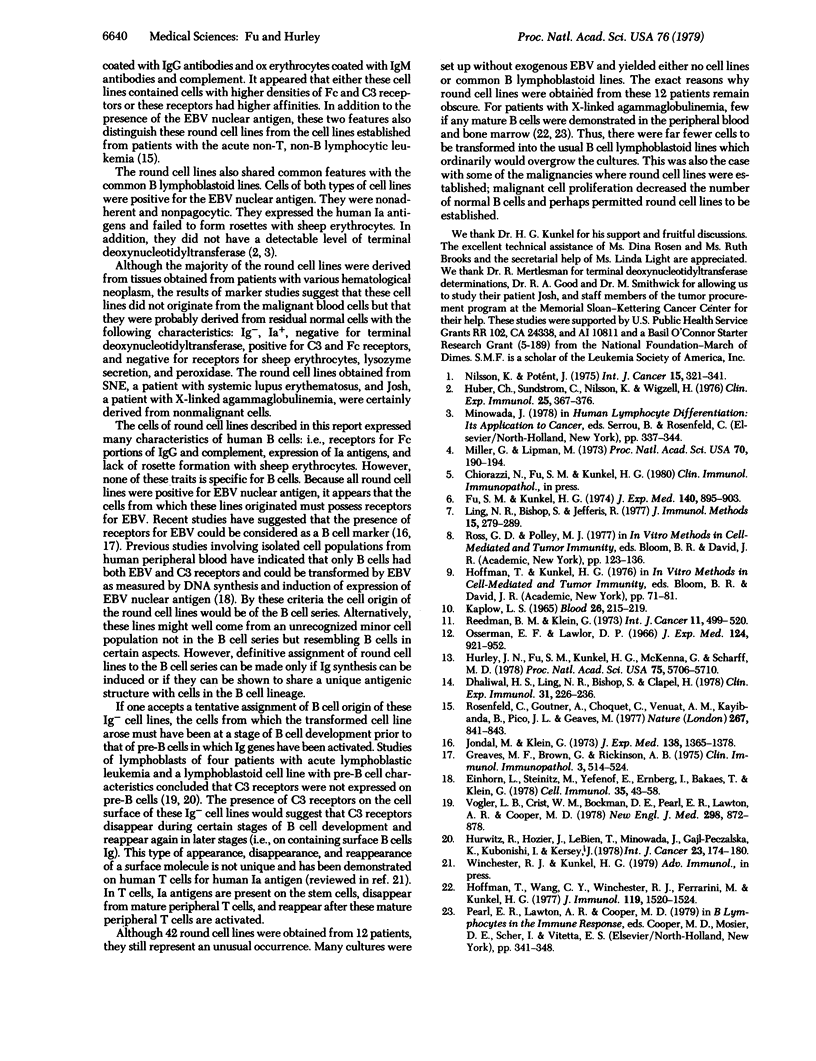Abstract
A group of very similar cell lines was established from peripheral blood or bone marrow of 12 patients with a variety of disorders. The cells in these cell lines were uniform and round in shape. They grew as single-cell suspensions or as aggregates of small numbers of cells in stationary culture. The most striking characteristic of these lines was the lack of cells with surface immunoglobulin or with demonstrable immunoglobulin synthesis. This lack of immunoglobulin synthesis and their special growth characteristics distinguished them from the lymphoblastoid B cell lines previously described. The cells of these unusual cell lines had strong Fc receptors and C3 receptors and expressed Ia antigens. They did not form rosettes with sheep erythrocytes and did not have detectable levels of terminal deoxynucleotidyltransferase. They did not secrete lysozyme and failed to stain for peroxidase. The presence of the Epstein-Barr virus nuclear antigen in the cells indicated the presence of Epstein-Barr viral genome. The possibility that these cells represent some type of precursor cell in the B cell lineage is discussed, but the exact cellular origin remains to be ascertained.
Full text
PDF



Images in this article
Selected References
These references are in PubMed. This may not be the complete list of references from this article.
- Dhaliwal H. S., Ling N. R., Bishop S., Chapel H. Expression of immunoglobin G on blood lymphocytes in chronic lymphocytic leukaemia. Clin Exp Immunol. 1978 Feb;31(2):226–236. [PMC free article] [PubMed] [Google Scholar]
- Einhorn L., Steinitz M., Yefenof E., Ernberg I., Bakacs T., Klein G. Epstein-Barr virus (EBV) receptors, complement receptors, and EBV infectibility of different lymphocyte fractions of human peripheral blood. II. Epstein-Barr virus studies. Cell Immunol. 1978 Jan;35(1):43–58. doi: 10.1016/0008-8749(78)90125-9. [DOI] [PubMed] [Google Scholar]
- Fu S. M., Kunkel H. G. Membrane immunoglobulins of B lymphocytes: inability to detect certain characteristic IgM and IgD antigens. J Exp Med. 1974 Oct 1;140(4):895–903. doi: 10.1084/jem.140.4.895. [DOI] [PMC free article] [PubMed] [Google Scholar]
- Greaves M. F., Brown G. Epstein-Barr virus binding sites on lymphocyte subpopulations and the origin of lymphoblasts in cultured lymphoic cell lines and in the blood of patients with infectious mononucleosis. Clin Immunol Immunopathol. 1975 Mar;3(4):514–524. doi: 10.1016/0090-1229(75)90076-8. [DOI] [PubMed] [Google Scholar]
- Hoffman T., Wang C. Y., Winchester R. J., Ferrarini M., Kunkel H. G. Human lymphocytes bearing "Ia-like" antigens; absence in patients with infantile agammaglobulinemia. J Immunol. 1977 Oct;119(4):1520–1524. [PubMed] [Google Scholar]
- Huber C., Sundström C., Nilsson K., Wigzell H. Surface receptors on human haematopoietic cell lines. Clin Exp Immunol. 1976 Sep;25(3):367–376. [PMC free article] [PubMed] [Google Scholar]
- Hurley J. N., Fu S. M., Kunkel H. G., McKenna G., Scharff M. D. Lymphoblastoid cell lines from patients with chronic lymphocytic leukemia: identification of tumor origin by idiotypic analysis. Proc Natl Acad Sci U S A. 1978 Nov;75(11):5706–5710. doi: 10.1073/pnas.75.11.5706. [DOI] [PMC free article] [PubMed] [Google Scholar]
- Hurwitz R., Hozier J., LeBien T., Minowada J., Gajl-Peczalska K., Kubonishi I., Kersey J. Characterization of a leukemic cell line of the pre-B phenotype. Int J Cancer. 1979 Feb;23(2):174–180. doi: 10.1002/ijc.2910230206. [DOI] [PubMed] [Google Scholar]
- Jondal M., Klein G. Surface markers on human B and T lymphocytes. II. Presence of Epstein-Barr virus receptors on B lymphocytes. J Exp Med. 1973 Dec 1;138(6):1365–1378. doi: 10.1084/jem.138.6.1365. [DOI] [PMC free article] [PubMed] [Google Scholar]
- KAPLOW L. S. SIMPLIFIED MYELOPEROXIDASE STAIN USING BENZIDINE DIHYDROCHLORIDE. Blood. 1965 Aug;26:215–219. [PubMed] [Google Scholar]
- Ling N. R., Bishop S., Jefferis Use of antibody-coated red cells for the sensitive detection of antigen and in rosette tests for cells bearing surface immunoglobulins. J Immunol Methods. 1977;15(3):279–289. doi: 10.1016/0022-1759(77)90065-5. [DOI] [PubMed] [Google Scholar]
- Miller G., Lipman M. Release of infectious Epstein-Barr virus by transformed marmoset leukocytes. Proc Natl Acad Sci U S A. 1973 Jan;70(1):190–194. doi: 10.1073/pnas.70.1.190. [DOI] [PMC free article] [PubMed] [Google Scholar]
- Nilsson K., Pontén J. Classification and biological nature of established human hematopoietic cell lines. Int J Cancer. 1975 Feb 15;15(2):321–341. doi: 10.1002/ijc.2910150217. [DOI] [PubMed] [Google Scholar]
- Osserman E. F., Lawlor D. P. Serum and urinary lysozyme (muramidase) in monocytic and monomyelocytic leukemia. J Exp Med. 1966 Nov 1;124(5):921–952. doi: 10.1084/jem.124.5.921. [DOI] [PMC free article] [PubMed] [Google Scholar]
- Reedman B. M., Klein G. Cellular localization of an Epstein-Barr virus (EBV)-associated complement-fixing antigen in producer and non-producer lymphoblastoid cell lines. Int J Cancer. 1973 May;11(3):499–520. doi: 10.1002/ijc.2910110302. [DOI] [PubMed] [Google Scholar]
- Rosenfeld C., Goutner A., Choquet C., Venuat A. M., Kayibanda B., Pico J. L., Greaves M. F. Phenotypic characterisation of a unique non-T, non-B acute lymphoblastic leukaemia cell line. Nature. 1977 Jun 30;267(5614):841–843. doi: 10.1038/267841a0. [DOI] [PubMed] [Google Scholar]
- Vogler L. B., Crist W. M., Bockman D. E., Pearl E. R., Lawton A. R., Cooper M. D. Pre-B-cell leukemia. A new phenotype of childhood lymphoblastic leukemia. N Engl J Med. 1978 Apr 20;298(16):872–878. doi: 10.1056/NEJM197804202981603. [DOI] [PubMed] [Google Scholar]



